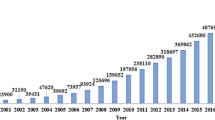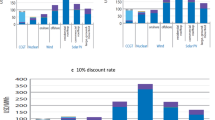Abstract
In contemporary times, renewable energy reliability has been an important field of research that is combined with the Internet of Things (IoT) including the opportunities for improving and challenging the work. Wind energy harvesting in IoT (WHIoT)-based framework is investigated considering the associated potential in the historical city of Bam is proposed in this paper. Weibull distribution function, wind power, and energy density were computed for three heights of 40, 60, and 80 m. The results at 80 m show that the maximum monthly wind speed average of 8.48 m/s occurred in July while the minimum value was observed in December with a value of 3.92 m/s. It was demonstrated that during the summer season power density and energy density are at peak values. This is an advantageous observation for Bam city with higher demand for energy during hot summer. The performance of six different wind turbines was assessed in terms of energy production and capacity factor. Finally, an economic assessment was performed to investigate the suitability of Bam city for the installation of small-scale wind turbines.








Similar content being viewed by others
References
Teimourian A et al (2020) Assessment of wind energy potential in the southeastern province of Iran. Energy Sour, Part A: Recovery, Util, Environ Eff 42(3):329–343
Ouammi A et al (2010) Monthly and seasonal assessment of wind energy characteristics at four monitored locations in Liguria region (Italy). Renew Sustain Energy Rev 14(7):1959–1968
Tizpar A et al (2014) Wind resource assessment and wind power potential of Mil-E Nader region in Sistan and Baluchestan Province, Iran-Part 1: Annual energy estimation. Energy Convers Manage 79:273–280
Mostafaeipour A et al (2013) Evaluation of wind energy potential as a power generation source for electricity production in Binalood Iran. Renew Energy 52:222–229
Morgan VT (1995) Statistical distributions of wind parameters at Sydney Australia. Renew Energy 6(1):39–47
Chang TP (2011) Performance comparison of six numerical methods in estimating Weibull parameters for wind energy application. Appl Energy 88(1):272–282
Mostafaeipour A et al (2011) Wind energy feasibility study for city of Shahrbabak in Iran. Renew Sustain Energy Rev 15(6):2545–2556
Eskin N, Artar H, Tolun S (2008) Wind energy potential of Gökçeada Island in Turkey. Renew Sustain Energy Rev 12(3):839–851
Wais P (2017) Two and three-parameter Weibull distribution in available wind power analysis. Renewable Energy 103:15–29
Tuller SE, Brett AC (1985) The goodness of fit of the Weibull and Rayleigh distributions to the distributions of observed wind speeds in a topographically diverse area. J Climatol 5(1):79–94
Bowden G, et al. (1983) The Weibull distribution function and wind power statistics. Wind Engineering, p. 85–98.
Keyhani A et al (2010) An assessment of wind energy potential as a power generation source in the capital of Iran, Tehran. Energy 35(1):188–201
Mohammadi K, Mostafaeipour A (2013) Economic feasibility of developing wind turbines in Aligoodarz, Iran. Energy Convers Manag 76:645–653
Mostafaeipour A (2013) Economic evaluation of small wind turbine utilization in Kerman Iran. Energy Convers Manag 73:214–225
Mostafaeipour A (2010) Feasibility study of harnessing wind energy for turbine installation in province of Yazd in Iran. Renew Sustain Energy Rev 14(1):93–111
Mostafaeipour A, Abarghooei H (2008) Harnessing wind energy at Manjil area located in north of Iran. Renew Sustain Energy Rev 12(6):1758–1766
Alhmoud L, Al-Zoubi H (2019) IoT Applications in Wind Energy Conversion Systems. Open Engineering 9(1):490–499
Al-Turjman F et al (2020) Feasibility analysis of solar photovoltaic-wind hybrid energy system for household applications. Comput Electr Eng 86:106743
Alhaddad M, et al. (2019) Aiming for smart wind energy: A comparison analysis between wind speed forecasting techniques. Transactions on Emerging Telecommunications Technologies, p. e3749.
Dimililer K, Dindar H, Al-Turjman F (2020) Deep learning, machine learning and internet of things in geophysical engineering applications: an overview. Microprocessors Microsyst 103613.
Khan M et al (2021) A new hybrid approach of clustering based probabilistic decision tree to forecast wind power on large scales. J Electr Eng Technol 16(2):697–710
Khan M, Liu T, Ullah F (2019) A new hybrid approach to forecast wind power for large scale wind turbine data using deep learning with TensorFlow framework and principal component analysis. Energies 12(12):2229
Batcha RR, Geetha MK (2020) A survey on IOT based on renewable energy for efficient energy conservation using machine learning approaches. in 2020 3rd International Conference on Emerging Technologies in Computer Engineering: Machine Learning and Internet of Things (ICETCE). IEEE.
Almonacid-Olleros G et al (2020) A new architecture based on IoT and machine learning paradigms in photovoltaic systems to nowcast output energy. Sensors 20(15):4224
Yeh C-H et al (2019) Machine learning for long cycle maintenance prediction of wind turbine. Sensors 19(7):1671
Demircan B, Akyüz E (2019) IoT and cloud based remote monitoring of wind turbine. Celal Bayar Univ J Sci 15(4):337–342
Alamdari P, Nematollahi O, Mirhosseini M (2012) Assessment of wind energy in Iran: A review. Renew Sustain Energy Rev 16(1):836–860
Wikipedia (2018) Bam Wiki.
Nedaei M (2014) Wind resource assessment in Hormozgan province in Iran. Int J Sustain Energ 33(3):650–694
Chang T-J et al (2003) Assessment of wind characteristics and wind turbine characteristics in Taiwan. Renew Energy 28(6):851–871
Mohammadi K, Mostafaeipour A (2013) Using different methods for comprehensive study of wind turbine utilization in Zarrineh, Iran. Energy Convers Manag 65:463–470
Diaf S, Notton G (2013) Technical and economic analysis of large-scale wind energy conversion systems in Algeria. Renew Sustain Energy Rev 19:37–51
Mirhosseini M, Sharifi F, Sedaghat A (2011) Assessing the wind energy potential locations in province of Semnan in Iran. Renew Sustain Energy Rev 15(1):449–459
Mostafaeipour A et al (2014) An analysis of wind energy potential and economic evaluation in Zahedan, Iran. Renew Sustain Energy Rev 30:641–650
Bahrami A et al (2019) Technical and economic analysis of wind energy potential in Uzbekistan. J Clean Prod 223:801–814
Bahrami A et al (2019) Assessing the feasibility of wind energy as a power source in Turkmenistan; a major opportunity for Central Asia’s energy market. Energy 183:415–427
Çakmakçı BA, Hüner E (2020) Evaluation of wind energy potential: a case study. Energy Sour, Part A: Recov, Util, Environ Effects 1–19.
Khlaifat N et al. (2020) Evaluation of wind resource potential using statistical analysis of probability density functions in New South Wales, Australia. Energy Sour, Part A: Recov, Util, Environ Effects 1–18.
Kandpal TC, Garg HP (2003) Financial evaluation of renewable energy technologies: MacMillam India Limited.
IRENA, R.P.G.C.i., (2017) International Renewable Energy Agency, Abu Dhabi
Iran, (2018) C.b.o.t.I.R.o.
Ahmadi A, Nabipour M, Mohammadi-Ivatloo B, Amani AM, Rho S, Piran MJ (2020) Long-term wind power forecasting using tree-based learning algorithms. IEEE Access 8:151511–151522. https://doi.org/10.1109/ACCESS.2020.3017442
Author information
Authors and Affiliations
Corresponding author
Ethics declarations
Conflict of interest
The authors declare that they have no conflict of interest.
Additional information
Publisher's Note
Springer Nature remains neutral with regard to jurisdictional claims in published maps and institutional affiliations.
Rights and permissions
About this article
Cite this article
Teimourian, H., Teimourian, A., Dimililer, K. et al. The potential of wind energy via an intelligent IoT-oriented assessment. J Supercomput 78, 5221–5240 (2022). https://doi.org/10.1007/s11227-021-04085-9
Accepted:
Published:
Issue Date:
DOI: https://doi.org/10.1007/s11227-021-04085-9




